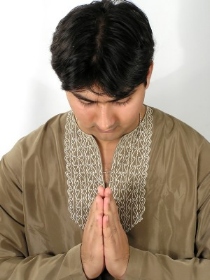 One of the interesting aspects of being in India is to observe non-verbal communication. Indians by and large are big talkers, but they also are very expressive non-verbally. Well-known is the greeting using the folded hands in front of the chest, often while saying “Namaste” or “Namaskar” (from Sanskrit, “I bow to you”). The gesture is accompanied by a slight bow. At the hotel where I was staying in Ahmedabad, the hotel employees greeted me that way every time we met. I have also noted while I’ve been here that, while Indians love to talk, they are also more comfortable with silence than most US Americans. There is not the same compulsion to fill pauses in conversation with chatter.
One of the interesting aspects of being in India is to observe non-verbal communication. Indians by and large are big talkers, but they also are very expressive non-verbally. Well-known is the greeting using the folded hands in front of the chest, often while saying “Namaste” or “Namaskar” (from Sanskrit, “I bow to you”). The gesture is accompanied by a slight bow. At the hotel where I was staying in Ahmedabad, the hotel employees greeted me that way every time we met. I have also noted while I’ve been here that, while Indians love to talk, they are also more comfortable with silence than most US Americans. There is not the same compulsion to fill pauses in conversation with chatter.
My colleague here told me of a personal experience of hers illustrating a difference between US and Indian behavior in this area. She was a graduate student at an American university and had, she says, been slacking off on her work. Her graduate advisor called her to his office to lecture her about buckling down. Abashed, she kept her head down during the conversation, not looking him in the eyes. This was her acknowledgement of his age and seniority, as well as a way to show her own awareness and confession of her guilt and shame. He didn’t take it that way, and became increasingly angry in the conversation, interpreting her not looking directly at him as a refusal to accept his views and to acknowledge her fault, in other words, the opposite of what she intended to convey. India is a hierarchal culture in which it’s expected that one show respect for age and authority. One way of conveying that is to lower your eyes.
The most intriguing gesture in India is surely the head wiggle. This is a circular bobbing of the head (like a bobble head) from side to side, neither a nod nor a shake. I have seen this gesture used very often and in many different contexts, and I just realized yesterday evening that I was unconsciously using it while listening to a colleague here tell me about her family’s tragic experiences during the separation between India and Pakistan in 1947. In this case, I was expressing sympathy and indicating Yes, I am listening, go on. But that’s just one use of the head wiggle. Depending on how it is done – how fast the wiggle – it can also mean yes or I agree. In other contexts, particularly if it is slow and subtle, it can just be an acknowledgement of the presence of another person – a kind of minimal greeting. According to one account, it can also be used as a non-answer, to not respond yes or no to a question, request, or offer. That kind of ambiguity can be quite useful in a culture in which it’s not acceptable to make definitive refusals of offers.
A YouTube video demonstrates the different uses of the head wiggle:
My colleage att IIK-Kharagpur pointed me also to this clip from the TV series Outsourced: